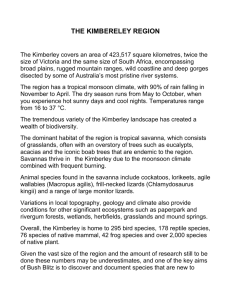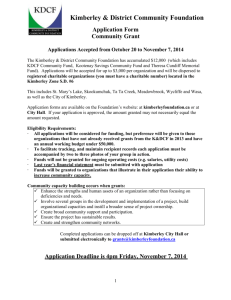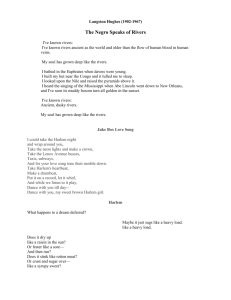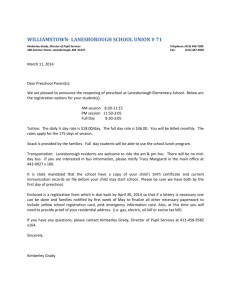Rivers of the Kimberley: Their Discovery and
advertisement
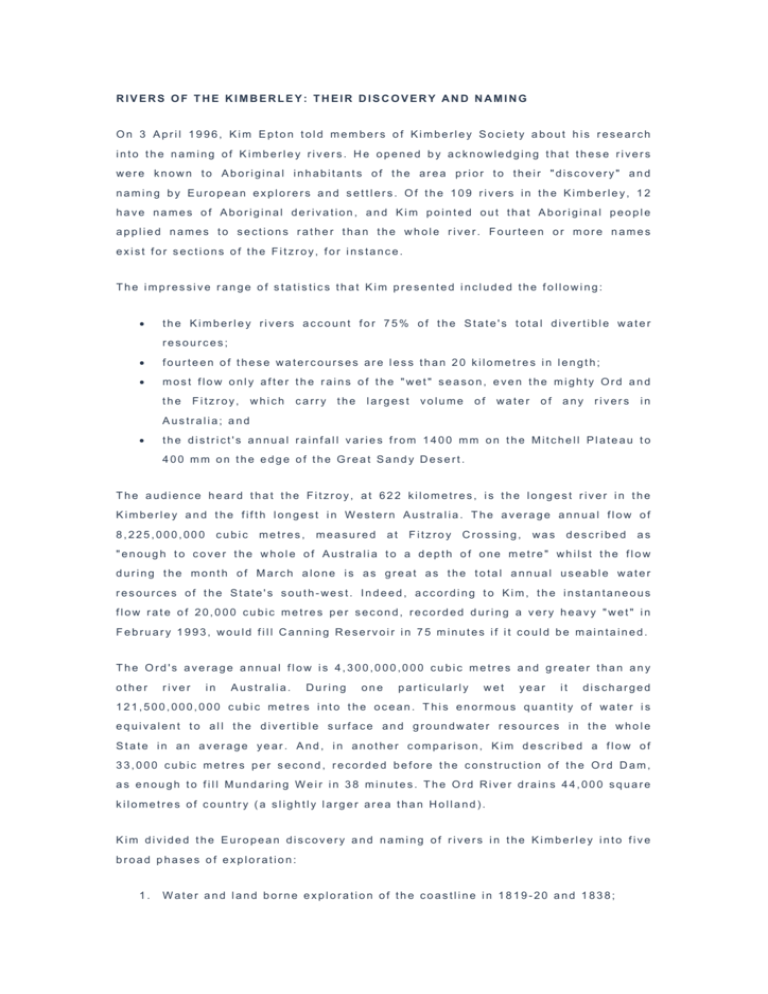
RIVERS OF THE KIMBERLEY: THEIR DISCOVERY AND NAMING On 3 April 1996, Kim Epton told members of Kimberley Society about his research into the naming of Kimberley rivers. He opened by acknowledging that these rivers were known to Aboriginal inhabitants of the area prior to their "discovery" and naming by European explorers and settlers. Of the 109 rivers in the Kimberley, 12 have names of Aboriginal derivation, and Kim pointed out that Aboriginal people applied names to sections rather than the whole river. Fourteen or more names exist for sections of the Fitzroy, for instance. The impressive range of statistics that Kim presented included the following: • the Kimberley rivers account for 75% of the State's total divertible water resources; • fourteen of these watercourses are less than 20 kilometres in length; • most flow only after the rains of the "wet" season, even the mighty Ord and the Fitzroy, which carry the largest volume of water of any rivers in Australia; and • the district's annual rainfall varies from 1400 mm on the Mitchell Plateau to 400 mm on the edge of the Great Sandy Desert. The audience heard that the Fitzroy, at 622 kilometres, is the longest river in the Kimberley and the fifth longest in Western Australia. The average annual flow of 8,225,000,000 cubic metres, measured at Fitzroy Crossing, was described as "enough to cover the whole of Australia to a depth of one metre" whilst the flow during the month of March alone is as great as the total annual useable water resources of the State's south-west. Indeed, according to Kim, the instantaneous flow rate of 20,000 cubic metres per second, recorded during a very heavy "wet" in February 1993, would fill Canning Reservoir in 75 minutes if it could be maintained. The Ord's average annual flow is 4,300,000,000 cubic metres and greater than any other river in Australia. During one particularly wet year it discharged 121,500,000,000 cubic metres into the ocean. This enormous quantity of water is equivalent to all the divertible surface and groundwater resources in the whole State in an average year. And, in another comparison, Kim described a flow of 33,000 cubic metres per second, recorded before the construction of the Ord Dam, as enough to fill Mundaring Weir in 38 minutes. The Ord River drains 44,000 square kilometres of country (a slightly larger area than Holland). Kim divided the European discovery and naming of rivers in the Kimberley into five broad phases of exploration: 1. Water and land borne exploration of the coastline in 1819-20 and 1838; 2. Land and water based exploration around Camden Harbour 1864-1865; 3. Alexander Forrest's 1879 major expedition, which opened up the Kimberley and the exploration which resulted over the next ten years including searches for pastoral land, the Kimberley Survey Expeditions and gold prospecting; 4. Frank Hann's penetration of the King Leopold Ranges in 1898, which was followed by Fred Brockman's 1901 expedition; and 5. Later exploration, mainly as a result of government activities. In moving on to factors that influenced the naming of the Kimberley rivers, Kim observed that "few areas are more subject to egotism, undue influence, toadyism, sycophancy and sometimes outright admiration than the efforts people make to have a name applied to a natural feature or enduring object". Five of the 11 persons who have held the position of Surveyor General of Western Australia from 1829 to 1987 (when it was abolished) had rivers in the Kimberley named after them. These men are: Malcolm Fraser, John Forrest, H.F. Johnston, F.S. Brockman and John Morgan. By comparison, only three of the State's Governors - W.C.F. Robinson, Sir Henry Ord and Sir Arthur Lawley - have been accorded this honour. Kim attributed this situation to explorers being more likely to honour their immediate superiors, and he pointed out that two rivers in the Kimberley - the Barker and the Townshend - were named after Governors' wives. The Mitchell River was named in 1921, by government surveyor William Easton, probably after Sir James Mitchell who was Premier and Minister for Lands at the time. Another three Kimberley rivers have been named after Australian politicians: Edmund Barton politicians), (Australia's and George first PM), Throssell Charles (member Moran for (one Northam of for WA's 20 youngest years and Commissioner of Crown Lands when the river was named). Of the remaining 95 Kimberley rivers, 19 were named for fellow explorers or expeditioners, i.e., Calder, De Lancourt, Durack, Fitzroy, Fletcher, Gibb, Hann, Helby, Hunter, King, Lyne, McRae, O'Donnell, Pentecost, Salmond, Thompson, Turner, Ullinger, and Woodhouse. Thirteen rivers were named after local identities, notably by Charnley, Pearson, meanings: Frank Hann, Chapman, and the Cunninghame, Traine. Irgulba, and Twelve Jinunga, people Fox, rivers so honoured Gliddon, were Kammargoorh, given were: Isdell, James, Aboriginal Kyulgam, Adcock, Barnett, Keep, names Lillybooroora, of Logue, various Lydarrba, Mundurrul, Parderoora, Tarraji, Warada, Yeeda, and Yuraddagi. Another twelve rivers were named after family members, friends, etc. called Berckelman, Berkeley, Dunham, Elvire, Lennard, Louisa, Margaret, Mary, May, Richenda, Roe, and Sprigg. Eleven more were given descriptive names, i.e. Black Elvire, Fish, Fraser South, Hann North, Little Fitzroy, Little Gold, Little Logue, Little Panton, Little Tarraji, Upper Panton, and the Watery River. Alexander Forrest's enthusiasm for naming features after foreign supporters of geographic research accounted for the nomenclature of some of the six rivers named after monarchs or overseas notables, i.e., Negri, Behn, King Edward, King George, Leopold, and Prince Regent. Five rivers were named for colonial officials resident in England or Western Australia, i.e. Chamberlain, Gairdner, Glenelg, Middleton, and Sale, whilst five were named after company directors, shareholders or landholders, i.e., Carson, Drysdale, Panton, Patrick, and Wilson. The Bow was named after an overseas river, the Meda after a ship, and, at the end of Kim's exhaustive list, we are left with ten rivers that have names of unknown derivation. These are the Armanda, Ernest, Frank, Keightly, Laura, Minnie, Nicholson, Stewart, Trent, and Wood. Among Kim's many accounts of the discovery and naming of the Kimberley rivers was the story of the 1963 discovery that the course of the De Lancourt River was shown in an impossible position on the then current public plan. The course had been derived from a sketch drawn by J.C. De Lancourt in 1926; but to enter the Timor Sea near Buckle Head, as shown on the plan, the river would have had to flow uphill! As a result, the course of the river was deleted from the public plan. To retain the name De Lancourt, however, it was applied to the largest, unnamed stream joining the Berkeley River south of Campbell Range. Despite this decision, the course of the river is still shown incorrectly on the current 1:250,000 and 1:100,000 topographical maps. In the upper reaches, the name De Lancourt River has been applied to a tributary and the main river is shown as an unnamed tributary. Kim has initiated action to have this error corrected and, whilst his accounts of other rivers are far too numerous to be covered here, more information is available in his book Rivers of the Kimberley: Their Discovery and Naming, private publication, Perth, 1996, 135 pp, ISBN 0 9586539 1 7. Cathie Clement

